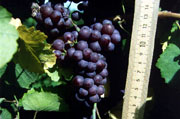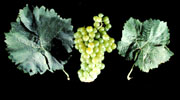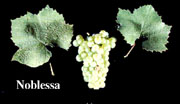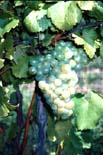European
(Vitis vinifera) Wine Grape Varieties
The first colonists of what is now New York State attempted
to grow European grapes, but failed. Successive attempts were all failures until
the 1960’s. Invariably, the failed vineyards died from winter cold injury,
but several underlying factors contributed to the failure to achieve satisfactory
cold hardiness. The fundamental reason is that V. vinifera vines generally
are less cold hardy than the American grape species used to produce interspecific
hybrids. However, equally important is the fact that these grapes have little
or no inherent resistance to several pests and diseases native to our state.
These include the grape root aphid, phylloxera, and several fungal diseases
(powdery mildew, black rot, and downy mildew). It was not until satisfactory
phylloxera-resistant rootstocks were identified and modern fungicides developed
that even the limited cold hardiness potential of these varieties could be attained
in the field. Recently we have found that V. vinifera varieties will
not succeed in soils traditionally used to grow American varieties unless the
soil pH is raised to about 6.5.
Another important factor that limited the success of these very
old varieties was the health of the nursery stock from which they were produced.
During the many centuries of culture, certain virus and virus-like diseases
have become very widespread in V. vinifera. In places in the world which
have less stringent climates, such as California, these diseases may have only
marginal impact on yield or grape quality. In fact, it has been suggested that
the vines may even benefit from a dwarfing effect. However, in New York’s
climate, anything that detracts from normal vine function is likely to reduce
winter cold tolerance. Certified planting stock which has been tested for known
virus pathogens is now available. Unfortunately, because of stringent federal
quarantine regulations, we have primary access only to selections from California
and are unable to test clones of these varieties which have been selected and
tested by European scientists to tolerate growing conditions more like those
of New York than California.
It is important to remember the vulnerability of European grape
varieties. Only sites which do not place extra restrictions on vine function,
such as poor soil or air drainage; excessive or inadequate fertility; or local
restrictions on growing season length should be used for V. vinifera.
In addition growers must use stringent measures to control diseases and insects;
superior pruning and training methods; and employ canopy management techniques
such as leaf removal which will enhance wood maturity and minimize disease.
These techniques are discussed in Cornell Miscellaneous Bulletin 111, Cultural
Practices for Commercial Vineyards (Jordan et al., 1980).
Those interested in information regarding vinifera varieties
should also visit Bob Pool's
Grape Pages.
Leading White Wine Vitis
vinifera Varieties
|
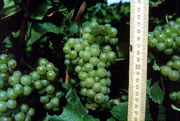
Chardonnay
Chardonnay is the most widely
planted V. vinifera variety in New York (Table
1). Relative to other V. vinifera varieties, it is cold hardy,
but not so hardy as White Riesling or Cabernet franc. Its advantages include
very high wine quality for both still and sparkling table wines; early
and reliable fruit and wood maturity; and moderate vigor. The primary
disadvantage is relatively high susceptibility to Botrytis bunch
rot. For that reason, the use of vertical training combined with summer
pruning and leaf removal have often produced superior results. Of the
several clones tested at Geneva, we have found the locally available New
York clone to be superior to those from Foundation Plant Materials Service
of California. Those clones tend to set excessive crops of very compact
clusters which rot easily and do not ripen reliably. Their vegetative
growth is excessive and winter cold injury often is the result.
|
|

White Riesling
White Riesling is also widely
planted because of its high relative cold hardiness and the excellent
quality of both still and sparkling wines made from its fruit. New York
White Riesling wines are probably superior to any except those of its
homeland in Germany. The major disadvantage is the susceptibility of its
fruit to Botrytis bunch rot and the relatively late harvest date.
White Riesling quite reliably reaches the maturity levels commonly chosen
in Europe (17-20% soluble solids) for the variety. The bunch rot susceptibility
suggests that extra canopy management techniques such as leaf removal
and extra sprays to combat bunch rot may be advantageous. Several excellent
clones are available, but older non-virus tested ones should be avoided
as they have reduced production potential in comparison to certified clones.
|
|

Pinot blanc
Pinot blanc, a white fruited
form of Pinot noir, is an important white wine
variety in Germany, Alsace and the Loire Valley of France. Adaptability
to New York growing conditions is similar to Chardonnay, and it has more
resistance to bunch rot . It seems worthy of more extensive culture in
New York.
|
|

Pinot gris
Pinot gris is the "grey"
(light red) form of Pinot noir. The clone we
have tested is not as cold hardy as our Pinot blanc clone, but is as hardy
as the better Pinot noir clones we have tested. It too appears to resist
bunch rot. Pinot gris makes a fuller bodied white wine than does Pinot
blanc. Both the blanc and gris forms add to the quality of sparkling wine
cuvées and make interesting still wines. They have the potential
to offer an interesting alternative to Chardonnay or White Riesling for
quality wine production.
|
|
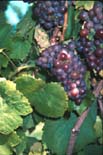
Gewürztraminer
Gewürztraminer
has red fruit but makes white wine with very distinctive spicy aromas
that have a selective market appeal. It is distinctly less cold hardy
than the best adapted V. vinifera varieties, and its high vigor
and long vegetative growth cycle have created problems in many New York
vineyards. The large vines result in shaded fruit, uneven ripening, and
less than optimal cold hardiness. On favorable sites and with appropriate
canopy management techniques, however, production and wine quality can
be excellent. We have only tested a single clone from California.
|
|
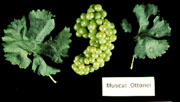
Muscat Ottonel
Muscat Ottonel is a productive
variety which does well in most years. However, if wood maturity is restricted
by cool summer temperatures or when winter cold is severe, cold injury
results. It’s cold hardiness is similar to that of Gewürztraminer.
It makes excellent muscat flavored wines, and is the best adapted of the
traditional muscat varieties in New York. Resistance to bunch rot is moderate.
|
|
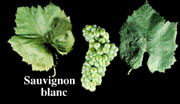
Sauvignon blanc
Sauvignon blanc has produced
outstanding wines in New York. However several major problems with the
variety suggest that it should be planted with caution. It is a very vigorous
variety with a long vegetative cycle. Cold hardiness is difficult to attain
in our climate, and its maximum hardiness appears to be quite low. The
clusters are very susceptible to Botrytis infection and the strong
vegetative growth produces a large canopy which increases bunch rot potential
and reduces vine fruitfulness. We have only tested a single clone from
California. Clones from Europe are reported to have shorter vegetative
cycles and might be better adapted to New York.
|
|
Pinot noir is one of the world’s
great red wine varieties. When fully mature, it produces superior red
table wines. Excellent sparkling wines can be produced when it is made
as a white wine. These may be made from Pinot noir alone, or by blending
with other traditional sparkling wine varieties. Because of its early
ripening (first week of October in Geneva) relative to other classic red
V. vinifera varieties and its reasonable cold hardiness, Pinot
noir is an attractive choice for the cooler production areas of New York.
However, the variety has two important defects. It tends to produce very
compact clusters of thin skinned fruit which are very susceptible to Botrytis
infection and subsequent bunch rot, and wines tend to be deficient in
color. Color is invariably a problem when the fruit is harvested early
to avoid bunch rot. Bunch rot is rarely a problem for sparkling wine production
because the fruit is properly harvested before bunch rot becomes a problem.
We have many clones of Pinot noir under
test and there are great differences among them. The following are primarily
|
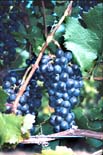
Pinot Noir "Mariafeld"
|
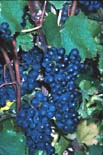
Pinot Noir "Geneva"
|
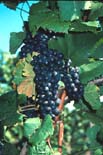
Pinot Noir "Gamay Beaufolais"
|
listed because of their general availability.
Pinot noir "Mariafeld" ("Klevner
Mariafeld") originated in Switzerland. It has the greatest resistance
to bunch rot of any Pinot noir clone we have tested. It tends to have
high yield, very large berry size and relatively low winter cold tolerance.
Normally these factors should discourage planting, but because harvest
can be delayed until full maturity, the clone often produces superior
wines to clones with higher quality potential which must be harvested
early to avoid bunch rot. The wines are high in color and tannin relative
to other clones. We recommend that "Mariafeld" be planted as
one of a mix of clones when red Pinot noir wines are desired. The
origin of Pinot noir "Geneva"
has been lost. Relative to other clones it has good winter cold hardiness
but bunch rot resistance is low. Pinot noir "Gamay
Beaujolais" is another variety whose moderate wine quality is
enhanced because bunch rot tolerance allows harvest to be delayed until
fruitisfully mature. Other clones currently being tested appear promising.
Before growers make planting decisions, they should check current information
on suitability and availability of alternative Pinot noir clones.
|
|
Pinot
Meunier resembles Pinot noir closely. It is among the most winter
hardy of the red Pinot family which we have tested and it is also the
most bunch rot susceptible. In France the variety is used solely as a
component of Champagne blends, and it would appear to be best suited for
that role in New York. Good red wines have been made, however, in years
of low Botrytis hazard.
|
|
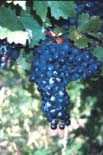
Cabernet Sauvignon
Cabernet
Sauvignon is one of the most cold hardy and disease resistant V.
vinifera varieties. Although late ripening, satisfactory levels of
sugar in most New York production areas are usually attained. However,
sugar alone does not determine wine quality, and consistent superior wine
quality has only been achieved in the warmer production areas.
|
|
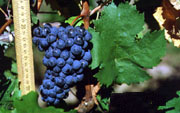
Cabernet franc
Cabernet franc should be considered
as an alternative or a supplement to Cabernet Sauvignon. It is the most
cold hardy V. vinifera variety we have tested. The fruit ripens
earlier and has produced quality wines more consistently than has that
of Cabernet Sauvignon.
|
|
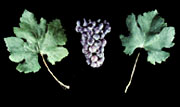
Merlot
Merlot has produced superior
wines in New York. However, it has a very long vegetative growth cycle
and tends to produce dense, shaded canopies. This leads to bunch rot and
reduced winter cold tolerance. It is not recommended for any but the most
favored sites in New York.
|
|
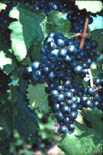
Limberger
Limberger
is grown under several different names in the northern production areas
of Europe (e.g. Lemberger, Blaufränkisch). There has not been wide
commercial testing of the variety in New York, but results to date have
been favorable. Cold hardiness appears acceptable and Botrytis
resistance is good. The clusters are large and yield potential is high,
which may dictate the need for crop control in some years. Wines have
been highly rated; they have deep red color and rich tannins.
|
|
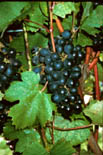
Gamay noir
Gamay noir
has only recently been tested in New York. It is the primary red wine
variety of Beaujolais in France, and New York wines have been well received.
We do not have enough experience to judge its real potential, and so plantings
should be considered experimental.
|
|
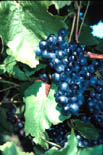
Trollinger
|
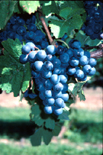
Rotberger
|
Trollinger
has been a consistent vineyard performer in tests at Geneva. In Europe
the variety is grown widely in northern regions to produce early maturing,
light red table wines. Experimental planting is suggested for producers
who are interested in wines of this type. A cross of Trollinger named
Rotberger has also been a consistent producer
of enjoyable fruity, red wines.
|
|
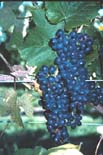
Petite
Verdot
Petite Verdot is the last of
the classic Bordeaux varieties to be mentioned in this publication. Yields
have been low at Geneva, fruit maturity is very late and wine quality
has been mediocre at best. We only recommend small trial plantings of
the variety for producers who wish to produce complex blends of Bordeaux
red wine varieties.
|







